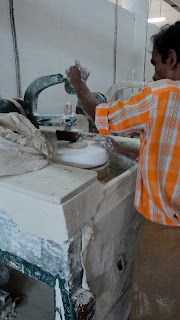Stimulus
Wednesday, September 14, 2011
Tuesday, September 6, 2011
Bone China Factory
I went to visit a Bone China Factory in Ankleshwar, Gujarat this weekend. The owner of the factory (Nishit Shah) happened to have met Thomas & Bhagyeshree at a bookshop before; where they got talking over a common book on Glazes. Nishit has started a studio in the factory for artists to come and work/explore/experiment more with the material and the idea of collaborating excited all of them.
The visit for me was to understand the processes and possibilities of the material and also to see if bone china was a good material to work with.
FACTORY IN OPERATION:
The bone is milled along with feldspar+scrap in a ball mill (picture 2, below) to make fine powder.
The mix is then mixed with water in large tubs. There are four such large tubs running at the same time.
After the mixing process the clay is sent through 4 machines like the ones below that have magnets to remove any iron content in the mix (iron reduces the whiteness of the clay body).
The cleansed clay is then sent through a compressor that removes all the water out and makes large ceramic plates. These Ceramic plates are sent into a tub again via a conveyor to make slip with the right water to clay proportion (the former being lesser than latter). The slip is then sent to the upper floors for slip casting through pipes.
The same process of cleansing and compressing is done for making a clay body with a different water to clay proportion (the former being lesser than the latter). The large ceramic plates are then carried manually to a pugmill for kneading.
The kneaded clay are stored in plastic bags for later use in quantities of 10 kg each.
The slip casting process involves, slip being poured in a mould, left to dry for 5 minutes to form a good thickness, the remaining slip being poured out, all the excess slip scrapped out and the mould being shut for further drying.
The slip caster does all of this simultaneously, while waiting for the initial 5 minutes to form a good wall thickness, he completes the remaining processes for the mould cast 5 minutes ago.
After the slip has dried and the pieces are ready for further processing, the cast pieces are removed from the moulds. These moulds are then assembled back together for the slip caster to use.
The handles are removed in a separate area and stacked together.
After the joining, the cups are sponged to finish them and then sent for drying.
In the meanwhile, in another department, saucers and plates are being made using a jig.
The hollow ware and flatware are finished in separate departments - remove excess clay, discard cracks etc.
All the completed pieces are then passed through a dryer before they can be fired.
The dried hollow ware and jig shaped ware are stacked separately in carts and sent into the kiln for a bisque firing.
After the first firing the bone china pieces are checked for any undulations. If any such issues are found the chinaware is sent through a pebble mill to fix the problems (to the maximum possible).
The bisque fired ware is then glazed in two ways, one for general chinaware and the other to apply ceramic transfers on. The quality and amount of glazing differs for the two.
The glazed ware is then sponged at the rim to remove any excess glaze. This is to not allow the glazed piece to fuse with the bottom surface when fired.
Moulds are made in a separate department. Highly skilled artisans make the Master Mould, the master mould is used to make Casings (shown in picture 1). The master mould is then kept safely and the casings are used to making a Working Mould (picture 2). Each working mould is used to make Production Moulds (picture 3). These production moulds are then used to cast the slip.
Subscribe to:
Comments (Atom)
































































